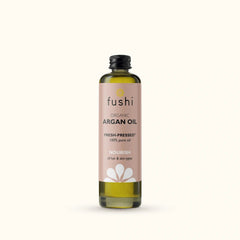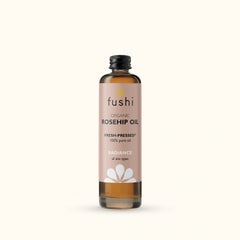Combination skin is one of four common skin types, the others being normal, dry and oily. While the other three can be more straightforward to treat, the combination skin type takes a little more care as you need to balance multiple skin types at once. Wondering where to start? Keep reading as we break down exactly what combination skin is, how to identify and care for it.

What is combination skin
Put simply, combination skin is when you experience more than one different skin type on your face. Most commonly, you may have areas where your skin feels oily and others where it feels dry. The t-zone - the forehead, nose and chin - naturally produces more oil than any other area on your face, however those with combination skin might see a more pronounced difference between the oily and dry parts on their face. The sebaceous glands in the t-zone, which are responsible for producing sebum, or what we know as oil, may be more overactive than someone who has a normal skin type.
Combination skin is actually one of the most common types, however it can easily be confused for oily skin. That’s because people may spot the oily t-zone areas of their face and immediately assume that their skin is oily due to it. If the rest of their skin is also oily, they likely do have oily skin. However, if they also suffer from dull or dry areas, it’s probably combination skin. It’s really important to consider the t-zone and other parts of the face when determining your skin type, but don’t worry, we’ll explain exactly how to identify whether your skin is combination type in a second.

What causes combination skin?
First, let’s talk about what causes combination skin. As with most skin types and concerns, they can be determined by genetics or a number of external factors.
Genetics play a big part in how your skin behaves, and it can be very common to inherit certain skin types or characteristics from your parents. While this is something that can’t be changed, as it’s hereditary, it can help you to identify your own skin type. Aside from genetics, external factors that can impact your skin type are:
Seasonal change
Your skin type doesn’t always stay the same. Much like the weather it can fluctuate, and sometimes this is due to seasonal changes. In summer your skin might become oilier, and in winter you might see more dryness. This is your skin responding to the shift in temperature and climate.
Hormones
Hormones also affect how your skin behaves. Androgen and estrogen are two hormones that have been found to be related to the oil production on your skin. If there is an imbalance in the level of these hormones, or your body thinks that there is, your skin might try to fix it by producing more oil to try and compensate. This change in hormones often occurs during puberty, pregnancy and menopause and before menstruation.
Your current skin care routine
The products that you’re applying can aggravate your skin type or even change it. Using products that contain harsh ingredients or ingredients that are not suitable for your type will only cause more issues rather than resolving them. They might increase oil production on your t-zone whilst also drying out the other parts of your face. Identifying the correct products to target combination skin will help to alleviate the condition.
Lifestyle
On the opposite spectrum to how genetics can inform your skin type, your lifestyle can also affect how your skin behaves. Smoking, getting too little sleep and diet and hydration can all have a huge impact on your skin type.
Characteristics of combination skin
Now you know what combination skin is and what causes it, let’s talk about how you can identify it.
Combination skin can be spotted if your skin appears to behave differently in different areas. For example, one of the most popular symptoms of combination skin is an oily t-zone but dullness and dryness on your cheeks. It doesn’t just have to be oiliness or dryness though. Your skin might be a mix of dry and normal, or oily and normal. Here are a few things to look out for to help you identify whether your skin is combination type:
Noticeable pores on and around your nose
If you think you have an oily t-zone as it’s producing more sebum than usual, you might notice that the pores on and around your nose and forehead are larger than the pores on the rest of your face. This is because they can become blocked by the excess sebum, which enlarges the size of your pores.
Blackheads, whiteheads and spots popping up in your t-zone
These types of blemishes are caused by oil building up in your pores and mixing with dead skin cells and dirt. If you’re noticing lots of these blemishes popping up around your nose, forehead and chin, it may be a sign that you’re suffering from an oily t-zone.
Patches of dryness or flaking
Does your skin feel dry and appear to be flaking around your cheeks, despite suffering from blemishes around your t-zone? This is a clear sign of combination skin. Your skin may not be flaking, but if your face feels tight, itchy or looks dull, these can all be signs of dry skin too.
Your t-zone reacts to the weather
If your t-zone gets noticeably more oily when the weather heats up, this is also a sign that you may be suffering from combination skin.
You’re also suffering from dandruff
Suffering from dandruff doesn’t always mean that you have combination skin, however, it can be common for women with this skin type. If you have dry, flaking skin on your face, it can also appear as dandruff.
Your normal moisturiser makes your t-zone extra oily
Your skin may have recently changed type, and as a result, you might be using the wrong skincare for it. If you’re using a moisturiser for a normal skin type, it might make your cheeks and dry patches feel hydrated but cause your t-zone to feel really oily. Don’t let this put you off using moisturiser on your oilier areas, just be sure to find a cream that’s suitable for combination skin.
Still unsure as to whether your skin is a combination of types? Try this. Wash your face with a gentle cleanser and then wait for 20 to 30 minutes afterwards without applying anything else. If you can spot oil on certain parts of your face but not in others, it’s likely that you have oily skin.

How to treat combination skin
The key to treating combination skin is being able to balance your skincare to give each part of your face the care it needs. The oily areas will prefer oil-free formulas that don’t increase shine, whereas the drier parts will require hydration and more emollient products that lock in moisture.
The best way to achieve this is to use targeted products on the different sections of your skin that need them. Otherwise, applying a product that’s meant for the drier areas of your face to your t-zone might make it extra oily. Give your skin exactly what it needs, where it needs it.
The best moisturiser for combination skin to treat the oily areas will be one that is lightweight, oil-free, water-based and in a gel or thin texture. This will help to prevent your pores from getting blocked. Don’t be tempted to skip the moisturiser either! Your skin, no matter how oily, always needs a moisturiser to keep it supple and soft. It’s just important to find the right one for your skin.
For the drier areas, look for an emollient, rich or creamy moisturiser. This will provide your dry spots with the moisture it lacks. Apply only to the areas that need it. We might be biased but we love our BioVedic™ Radiance Face Cream for providing deep hydration and nourishment to the areas that need it the most, while leaving skin radiant and glowing.
Alternatively, you can apply your lightweight moisturiser over your whole face and just layer over your hydrating cream on the drier parts of your skin. If your face is feeling extremely dry in parts, why not try giving them an extra boost of nourishment with a facial oil? Facial oils are excellent for applying as the last step in your skincare to lock in the products that you’ve used before, and prevent water loss from the surface of your skin.
As well as layering your moisturisers, it’s also important to remove any built up dirt, impurities or dead skin cells regularly. Cleansing your skin before you apply your moisturiser is a must, as it will help to clear out your pores, prevent them from getting clogged and ensure your skincare is fully absorbed.
We believe that the best cleanser for combination skin is gentle, not overly abrasive but is still effective at clearing all the impurities from your skin. Discover our BioVedic™ Enzyme Face Wash for a cleanser that exfoliates, rejuvenates and brightens, all while delivering moistures and balancing the skin’s pH level.
Our final tip for treating combination skin is to always ensure that your skincare is free from any comedogenic or skin-irritating ingredients. Comedogenic products can block your pores and lead to skin concerns like blemishes, whereas products formulated with harsh ingredients may cause irritation and exacerbate dry areas. Always choose non-comedogenic products that are made with kind-to-skin ingredients.
Fushi skincare is always organic and made with fresh-ground herbs and fresh-pressed oils to nourish, protect and care for the skin. Discover all our organic face care here to help care for normal, oily, dry or combination skin.


